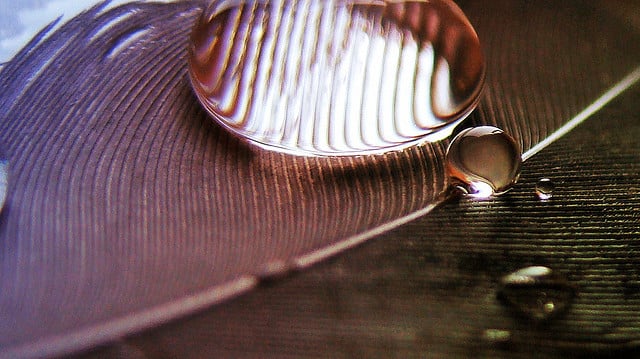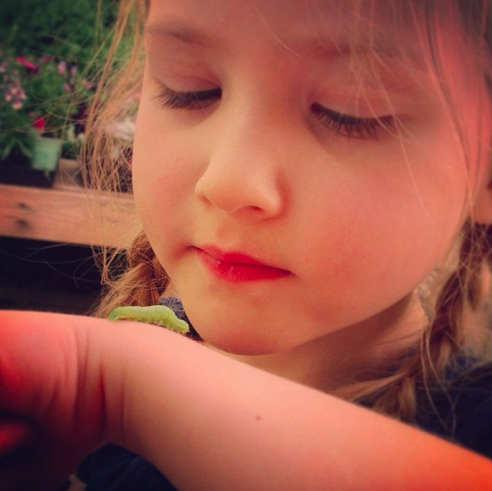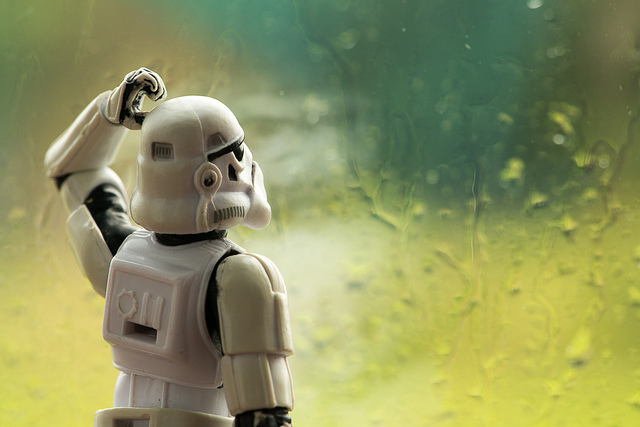Disclaimer
I apologize outright if you are in a drought-stricken region desperately searching the web for a glimmer of hope, only to have arrived at this post courtesy of the title. That’s not what this is. There are no deluge-inducing instructions here. No rain chants. Barely a plea. But questions? Yes. This post is about a plethora of questions.
Droplets
While sitting on the deck taking in a beautiful early evening outside, I began my traverse of the daylight/dusk/night barrier when my five year old daughter approached me at the table on the deck, and asked to climb into my lap. While shimmying in for kitten-like comfort, she kicked up a seemingly simple conversation…
Neve: “What are you reading?”
Me: “Oh… just about about ways of thinking. Just something to help me be smart about the work I do.”
Neve: “So, can you read a book to get smarter about anything?”
Me: “Almost. Yep… If you think about something you want to learn about, or know how to do… you can probably find a book to help you. You can pretty much learn about anything you want to today.
So, yeah… if you want to learn something, we’ll find books and things to help you.”
Neve: “Can you get a book if you want to learn how to make it rain?
Me: “(pause) Well… actually yes. Probably. There are people who have been trying to make it rain for a very long time. And sometimes they’re getting pretty OK at it in small spaces. Sort of.”
The conversation from there got a little too lengthy and geeky to relay here, but you get the idea. Learning at age five has so…… so much potential. Infinite, really.
Showers
I’m really not entirely certain what the segue might have been between these two events, but, fast-forward twenty minutes to when I posted this*:
“Holy cow…… the girls asked what a cardinal sounds like. I pulled up a video from the Cornell Ornithology Lab on my iPhone, and seriously, our backyard is now a cacophony of cardinal music.
Why have I not done this until now?”
The comment stream below the post was rich as well, with several connections from those who had done similar things, as well as some fantastic suggestions for taking this to the next level. I get smarter, kids get smarter, rinse, repeat.
Cloudburst
Once the girls heard the cardinals come to life around us, once they saw two land on the fence directly in front of us, they were in. “What does a goldfinch sound like?” “What about an oriole?” “Does a hummingbird make a sound?” While we Googled every last question in the fading light, I tried to interject a thing of two about the limits of their quick little tests. “Maybe those other species weren’t close by.” “Perhaps this was the wrong time of day for them to respond in that way.” Maybe this, perhaps that… but at this point they had already crossed over into trying to mimic backyard birdsongs themselves to even hear my prompts. At this point, science was bridging a wee bit into art and I knew this wouldn’t be the last time we attempt such an exploration.
Here is my question for you: do you realize how close real, honest-to-goodness, publishable scientific inquiry is from this very point? Once you’ve asked a fascinating question (often by accident) and taken the time to muck about and explore the elements of the investigation, you are so close to real sophistication. The sophistication of the process. It is at this point you begin to take those “what ifs” and figure out the scope of what you might be able to find out next. You’re digging into what others have already discovered. You are figuring out feasibility. You are formalizing. Little kids don’t need names for these things to inquire, they just need a guide. A guide who will stay out of the way. A guide willing to intervene minimally and only when needed, but a guide that is curious and kind enough to keep pushing. Gently pushing. Ask questions to get questions. Fewer answers. More possibilities.
Science education begins quite young if you let it. Ask the questions. Keep asking them. Once you get more in return than you give… you’re winning. Go ahead, make it rain.
Artwork *”Family Tree of Droplets” by HUSO on Flickr via CC. *”Neve and The Inchworm” by me. *”Today Weather” by kristina Alexanderson on Flickr via CC.


“Good questions are fabulously difficult to come up with.”
— Darren Kuropatwa, NKC Schools convocation keynote speech, August, 2013.
Fabulously true.
That was a pretty epic keynote. A whirlwind of good ideas in one sitting. I think I’ll watch it again: http://goo.gl/WdNM0C
Cheers Mike!
@Sean Kids ask the best questions, don’t they? 😉 FWIW I plan to take my girls into the backyard tonight with the phone and call up as many different birdsongs as we can think of. This idea is sheer genius!
It always struck me as a little strange: my Gr12 students rarely, if ever, asked me questions in class I couldn’t answer. Gr7 kids made me go home & do homework. Now, my littlest girls (5 & 7 y.o.) ask the toughest questions. I used to try to answer them. After reading Mindset I habitually respond with “Why do you think that is?” We have great conversations.
The other day at dinner, my 7y.o. Shoshanah asked me a question and I quickly answered her. My son Kas (17) scolded me for answering a question instead of asking something that made her think … then he lead the conversation. It was a proud papa moment. 😉
Kas is certainly paying attention, isn’t he?
And really… the fact that 12th graders seem so willing to sit in the back of the bus and go along for the ride is that by age 17 they’ve been spoonfed so much that they learn how much easier it is. And really, when you’re 17 there are enough things on your mind socially that you’ll generally take being spoon fed without putting up too big of a resistance.
Try the bird call approach a time or two yet? I’d love to know how well that worked for you. It seems that timing is pretty critical. The second time we tried, we only got reactions from Blue Jays.
Cheers!
Hi Sean, I have really appreciated reading your blog and learning your perspective about education and the way you see the world. Many of your views align with what I am currently being taught in my educational program.
We have been learning questioning techniques that put questions back on the students rather than back and forth Q&As between the teacher and one student. Do you have any explicit advice for a teacher-in-training on how I can engage students in lessons through questioning? Thanks!
I do actually. Hopefully some of this meets you at the right place and right time. It is always tough to guess online and via text only. I would be glad to talk this out a bit more via Skype/Hangouts at some point if you’d like.
1. What subject(s) do you teach and at what level?
2. Do you have access to some sort of coach? Instructional coach, peer who can observe, etc? Perhaps simply your cooperating teacher if you’re still an undergrad? If so… that is one of the first things you can do when studying questioning. Invite someone in with the explicit focus of recording every question asked by anyone in the room for a period of no more than 15 minutes. It can be as simple as diagramming the tables/student seats in the room and then drawing an arrow for each question.
An arrow pointing TO a student and FROM you indicates one question asked of that one student. An arrow pointing from one student to another indicates students questioning one another. A general question from you directed to the entire class could be simply hash marked in one corner of the page. You can even go so far as to have them add addition coding to the arrows. What was the verb in the question? Can they be coded to indicate higher or lower level questioning? Do that a few times in a week and then look for patterns. Who is doing more of the questioning in your room? What sort of questions are you asking? Who is doing all of the answering? That is one helpful (albeit teacher-focused) strategy to begin examining your practice.
3. At some point in the past two decades as a science educator I realized that questioning is so front-and-center to what is required for authentic scientific thinking. At that point, I shifted my focus from the questions I was asking (which I had paid careful attention to for some time by then) to the questions my students were asking. I was teaching 10th through 12th graders and I was unsatisfied by their ability to ask really good questions. I quickly realized that I couldn’t simply WILL them to ask better questions. I realized I would have to teach them, and it would have to be embedded within our day to day classroom practices.
I started using visuals in a simple, yet sophisticated little protocol we referred to as the “windowpane” strategy: https://www.scribd.com/doc/41239721/Windowpane-Strategy I would kick off a unit of study with one or a series of somewhat abstract, provocative images that would elicit thinking around the content we were about to learn. For example, this image is one I used this week with 5th grade teachers in our district: https://www.flickr.com/photos/nashworld/15168060113/ The content standard they were heading into dealt with water resources and man’s effect on those resources. You can tell much of my strategy for selecting those specific images.
To shorten a really long story, I realized that you can just say “ask better questions.” You have to teach kids to SEE again. To carefully observe. That is the deepest root of a question. We would always begin in total silence by scribbling observations in the first quarter of the page. Just observations. What do you see? A red barrel? Water in three states of matter? A child drinking impure water? Or wait… is that an inference? Do you know this? What are the observations that this inference in pinned upon? Students quickly realize to be mate cognitive about their thinking. Not just ARE they thinking… but WHAT they are thinking.
Still in silence, you move around the room and see students are ready give them the cue to scribble questions in the third quarter. Along the way, point out that every questions begins with an inference, which in turn has roots in an observation. They could then construct questions from the ground up when they thought they were stuck. They were learning to think… and the end result was that they became questioning champions and that skill then transferred all over the place. Eventually, we began to categorize questions and develop a student-created hierarchy for the types of questions that could be asked about nearly every topic.
And this one little strategy led me to realize one of my tightest rules as an educator today: never be the first to open your mouth on any given bit of content. Teaching kids the underpinnings of how to question the world around them, set them up to spill their conceptual knowledge (along with misconceptions) out into the air, and onto the page. After that, I was so much more prepared to enter into the conversation with “just in time” input as opposed to “just in case” spouting about what I thought they needed at that time.
Anyway… that was a pile of blabbing. Sorry to drone on, but you tapped into a topic of some significant passion. See how good you currently are asking a well-crafted question? 😉
This is such a great post! Sometimes we need to embrace the five-year-old wonder in all of us that likely drove our career paths toward science. As a future secondary science educator, I find it fascinating that a simple question from your daughter sparked such a thoughtful discovery. Considering my inquiry-based pedagogy, I think this is a perfect example of how curiosity in conjunction with exploration can lead to “answers” to many questions we have about the world around us. I also appreciate how this post acknowledges the simplicity of discovering new things if we only take the time to think, predict, and test reasonable hypotheses. With all the valuable tools at our fingertips, we can participate in learning science even more frequently in our every day lives!